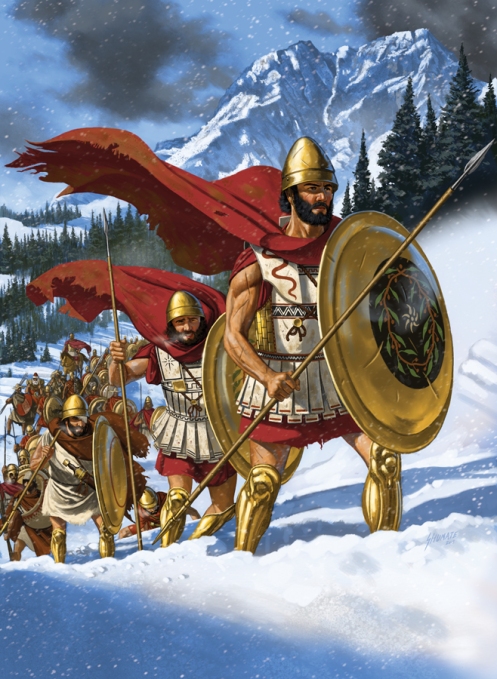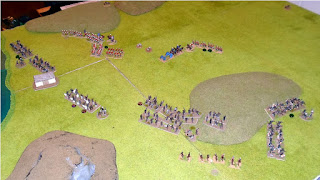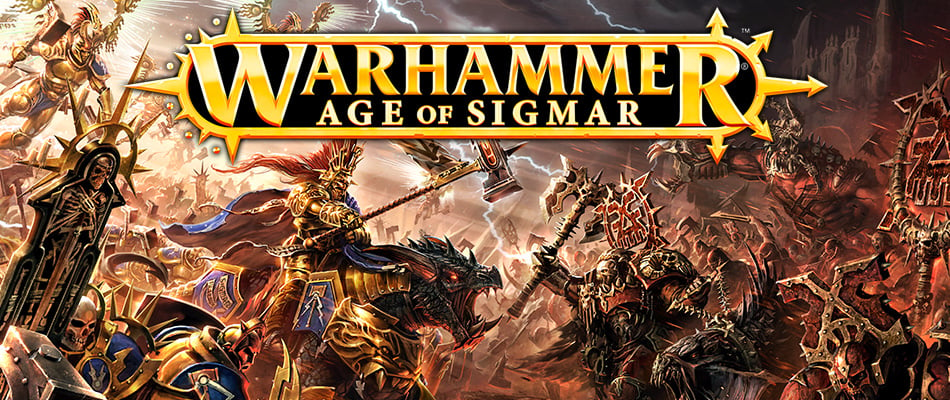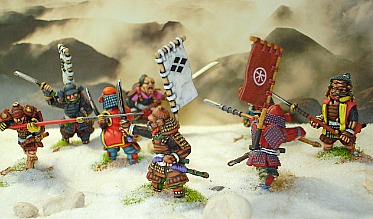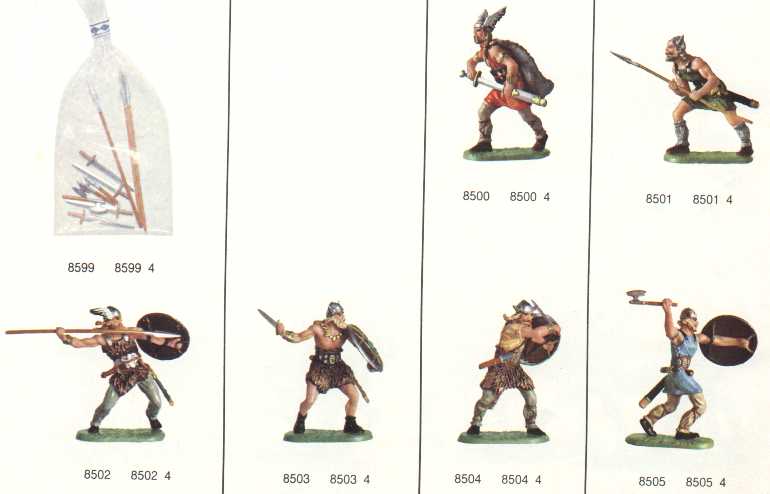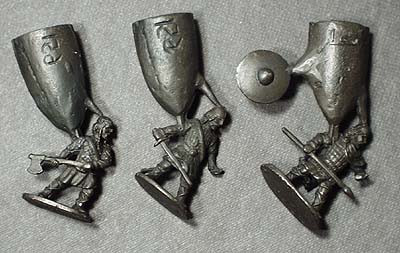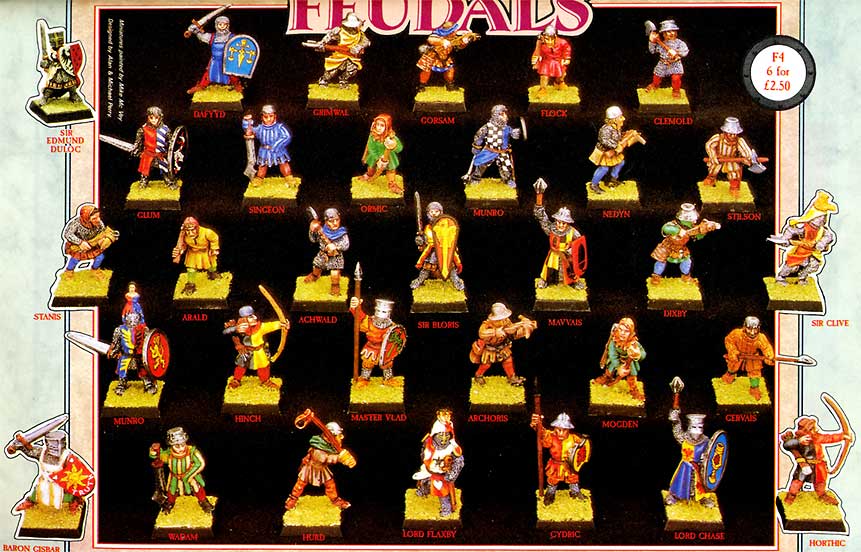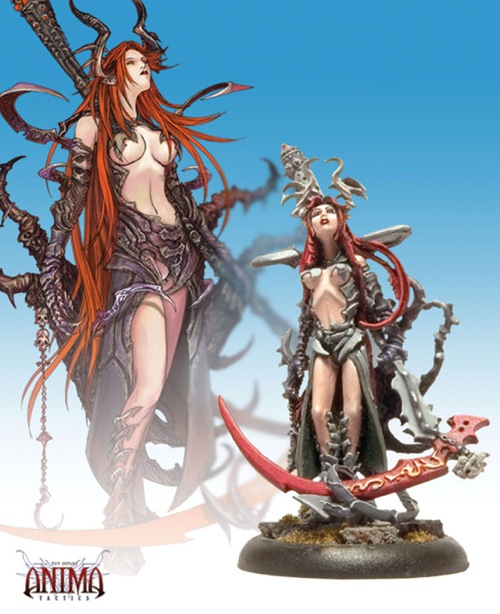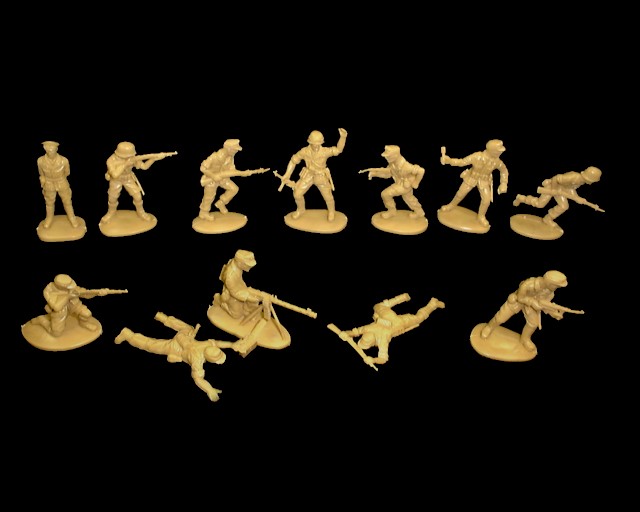I was determined not to write the rules off until I had at least given them a try. Games Workshop's new baby has been out there for a couple of weeks now and I finally had a chance to try it a day or two ago. What follows are my thoughts on that particular game and the rules as a whole.
We tried to play the game as written as much as possible, and so followed the rules as written to the letter, this seemed only appropriate for a review and initial test. However myself and my opponent, Matt, did agree on one fundamental change: We would measure all movement and issues of contact from bases, not figures.
The rules state bases are irrelevant - except to stop the models from falling over - and that measurements are taken from any part of the figure. Now this clearly will lead to issues, and seems on-line at least to have been interpreted as you 'always use the most extended part of the model'. In essence the rules don't state that, but good old GW show all their previous form in this system by writing rules in such an ambiguous way that it is easy for them to spark arguments about intention and meaning.
Quite aside from the fact that this rule makes a figure with a levelled spear able to attack a model further away than one holding it aloft, and a flowing cape may make a figure have more range than the same one modelled without it... The rule as written makes little sense; but it is easily common-sensed around. We opted for bases; this meant that figure size essentially became standardised and fair, and negated the potential need to stack one base upon another, something most gamers would be loathe to do. Using your common sense is a strong theme of these rules, and in that regard they are very much of an old-school design ethos. This is a point we shall return to.
Still, four paragraphs in and we've covered one rule. Let's get things moving.
Beforehand we agreed to a couple of restrictions on our forces. Armies in the game are made by choosing 'Warscrolls', essentially unit rosters, with the figures within that scroll having a certain number of wounds each. What these do not have, is any form of points value, either explicit or implicit, so you really need a gentlemanly approach to how you prepare forces.
One of the big complaints of gamers seems to be that this makes pick-up games and tournament play impossible. Well, we'll see. For now we had 51 wounds each (just how it worked out) and 5 Warscrolls each. Ogres versus Goblins; in Warhammer that would have been an enormous mismatch on face value.
We set up and rolled for the magical terrain. Table wise, a small layout seemed more than adequate for forces of such a small size. In AoS
all terrain is special terrain. This is not to say it is all wacky terrain, but as we rolled off the scenery we'd laid out it did throw up one oddity - The magical hedge capabl of improving a wizards casting ability seemed pretty unlikely. The other issue with terrain is the rules as written really imply it should have a base; as written a wall provides no cover if you stand
behind it, but if you stand
on it, it does! The easy fix is of course that if in base contact with the terrain feature you are 'on the terrain', but equally having terrain fixed to a base makes more sense and avoids arguments.
We split the table in half and got on with deployment. One point to note here is that you can declare you are stopping deploying at any time, you need not put out all your army. The other guy can then carry on until he is satisfied. If you haven't agreed an form of army size cap beforehand, you could both carry on until you simply run out of models. As will be seen this is not a great plan unless you like to win because the other guy had to go home to bed. But if, as Matt was, you find yourself out numbered by 4-3 or higher after deployment, you may elect to take a 'Sudden Death' victory condition.
Sudden Death conditions circumvent the normal victory condition of 'try to wipe out the other guy'; they include assassinating an enemy hero, and as Matt selected, occupying a key enemy terrain feature. The down side to this is that the sudden death condition will often go with the army with the toughest models, and so may well play to their strengths - in a balanced game this is more of a problem than in an unbalanced one. Had I proceeded to put the remaining 150 goblins out my box on the table, Matt's strategy would have been wholly justified, but also harder to carry out.
Sudden Death is a good riposte rule to playing people who try to win by having the most toys, whether it works in even sized games is another matter.
 |
| Initial Terrain and Deployments |
So we've deployed. You'll notice there are no formed units, no massed battle-lines, AoS does not prohibit these, there is just no particular benefit to them. Units will tend to close up in combat though. I guess if you are playing a bigger game, trays would save time in movement, but for sub-thirty figure armies like these it was irrelevant.
 |
| The Goblin horde |
There has been a lot of more positive talk on the net about the 'synergies' between different units. The way the Warscrolls are written is actually fairly clever (childish rules that some have aside), not hugely original, but clever. Certain combos work well together, for example, I took Skarsnik, who can inspire a unit of night goblins to double their attacks and become immune to Battleshock (morale) over fairly long ranges. this made my army much feistier than on paper it should have been.
This is smart, but then it is nothing that games like Magic: the Gathering haven't been doing for years now, so it is more a case of a application of modern game design than inventing something new.
 |
| A handful of Ogres |
As Matt finished deployment first He got first turn, but after that turn order is randomised, so it is quite possible to get two turns on the bounce. This is not always good thing, and certainly I had good reason on one occasion in the game to let Matt sneak first turn when I had won the roll and could've elected to go before him.
You start the turn with Hero actions; these may be commands or spells, and are detailed as appropriate on a unit/characters Warscroll. Some simply work, such as Skarsnik's powers, whilst others - magic mainly - require rolling. Spells can be powerful, but are thankfully simple. Casting involves rolling 2D6 against your target casting value, and your opponent may try to dispel it if he has a wizard in range by rolling over what you did. Magic definitely played into the goblins hands on this day, but was far less overpowering than in Warhammer before. Some may find it a little vanilla (most wizards will have the same two generic spells and one personal spell), but it works for such small games.
Anyway, knowing that the Sinister Shrine of Sigmar was his main objective, matt sent most of his force towards it. Units have a basic move, which they may extend by D6 if they run. Terrain has zero effect on most movement; unless as we did, buildings are declared impassable, linear objects simply remove their vertical height from the linear move.
 |
| Ogres loom in on their objective |
If you run you sacrifice your ability to carry out shooting or charge actions later in your turn. If you get within 3 inches of an enemy model, without a charge, you must stop. If you begin a turn in that position, you can stand still or retreat; that's all.
 |
| The Giant gets charged |
So to get all out of sequence, Matt charged my giant, my goblins having opened fire on some of his ogres over the way before also being charged by them. A charge can be declared if you are within 12 inches of your target, but you roll 2D6 for your permissible charge move so it pays to move in close first. Still even at 3 inches one of Matt's Ogre units failed it's charge and stood stock still.
Now in combat, any unit within 3 inches of the fight becomes involved and get 'Pile-in' moves to allow them to approach the enemy, but this is done in a neat sequence; the player whose turn it is chooses his first unit to fight, then the opponent may choose
any unit of their own, engaged in combat, to fight back with. Even if it is in a totally different melee. Therefore, you may get the drop on enemy units even though elsewhere you have been attacked already. The sequencing of this does nuance combat rather well.
 |
| Get 'em! Wheee! |
This, plus the special commands of Skarsnik made the Gobbo's more than hold their own against the Ogres on the flank. As to the mechanic for shooting and combat, it is ludicrously simple, and seems to be a nod to Kings of War, but fumbled in a manner that can only suggest they had to avoid copying it directly, even if the result was far inferior.
All units roll to hit based on the weapons they are equipped with, so for example an Ogre is hitting on 4+, regardless of his opponents ability (unless any special rules on their Warscroll applied) - Vampire count or Zombie as a target, the roll would still be a 4+. To wound is the same, only the Saves are really modified, where a weapon has 'Rend' which lowers the save. Unlike previous rules, a 6 is not always a success, nor a 1 a fail, so it is very possible to be left without hope of escape. But overall it did not feel like the Ogres carved through the goblins in the easy way they would have in Warhammer; Rank and file troops have evened out somewhat in this game. And you may well feel that is a good thing.
 |
| It all boils down to two big fights |
What certainly is a good thing, is that big monsters, get weaker as they are wounded, rather than being immense or dead but nothing in between. In their favour though, it seems that they are all of some use again. My Giant proved useful in a way that he never did in games of Warhammer, even if he did die in the end.
Once in combat though, there is no escape until one side is wiped out [Note: subsequently I'm reliably informed you
can disengage from combat if you wish, at any time, myself and Matt missed this, and it could change things somewhat]. Battleshock is what passes for morale, but from what I could see it would take a particular set of circumstance for it to be crucial.
 |
| The goblins were doing okay until reserves turned up |
If a unit loses models during the turn it must take a Battleshock test, rolling a D6 and adding the number of casualties to it. Note this is not wounds, models must've been removed from the unit, hence solo models are technically immune to Battleshock. Anyway, the result is compared to the unit bravery, and if it is higher than the bravery then the difference is the number of models that the unit loses due to fleeing.
In the whole game the was only one Battleshock test, I think this was partly due to the particular unit types and the special commands however. As a morale mechanic it is interesting, but ultimately fairly insignificant. The game essentially became a grinding match, and it was evident that it was one I wouldn't win. After four turns Matt controlled his building.
 |
| Victory! |
This was not an especially subtle game, and this is certainly a concern of the rules. I used to regularly run my armies with large numbers of flanking fast cavalry, and it is hard to see how these may work here. The game descended quickly into two protracted melees, and this seems a common experience to date. Additionally there are some very
odd rules. Most notably, that troops armed with missile weapons can mid-fight, stop, pull out their bows or whatever, shoot at a completely different target if they wish, and then resume fighting.
Sure, there are ways of rationalising that in some cases, but the idea of Ogres loading cannon whilst fending of a bunch of goblins in hand to hand combat seemed doubtful at least.
Similarly, you can say goodbye to much of the Warhammer you know and love/hate. No more Psychology tests, no fear, frenzy or terror, no warmachine misfires, no spell miscast table, no bemused monsters, no flank or rear charges, no challenges... A hell of a lot goes when you trim down to four pages of rules, even if you can put some of it back in to the unit rosters.
Of course in some of the Warscrolls for the classic miniatures there are some very weird rules, some may say humiliating. Such as pretending to ride a horse, or talking to your models, there are gamers who do that sort of thing anyway, but for some that would be a step too far, and is enough to put them of using those units, or even playing the game at all. So special rules may need agreeing to work around. Using common sense.
And so we are back to this point again. There is the core of a workable game here, but it is not one that can simply be pulled out the box and played without a dialogue with your opponent. My goblins fared better against Matt's Ogres than I expected, certainly better than I would've got in 8th edition, but to have had a real fighting chance in this encounter I would want another 10 or 20 wounds to even up the score. But if I do that, there is nothing other than not owning the models to stop my opponent throwing another dozen Ogres on the table, and so it could escalate.
There is no way - at present - of saying an encounter is balanced, and there may never, ever be. Scenario play is the balancing factor here, with the Sudden Death rule as a possible alternative. But for the competitive gamer, there is no certainty in this. It would be like turning up for a game of football, one team ready for five a side, the other with a full eleven; and the referee says play with who you brought, it's fair so long as the five as side team scores first they win anyway.
Can you have a decent game in this context? Yes, you can; but this is not the only issue. As with so many of Games Workshop's rules there is a vagary in the writing that allows room for no end of ambiguity. Those like me who were raised on the open rules of Featherstone and Grant can easily acommodate this but for many gamers the lack of a firm ruling in every situation will feel like it makes the rules unworkable,
Illogical rules like measuring from the model not the base, shooting out of combat and having to stand on terrain to be in cover will rile them almost as much as a lack of a points system. Casual play against regular opponents will work best, whether this can ever be made into a set of tournament rules remains to be seen (I wouldn't want it to but that's a personal view).
But my main issues with the game are twofold, and they are not any of the above.
Firstly the game itself is slow, for what it is. Given I played with 29 models and Matt with 11 this was a tiny game by old Warhammer standards, but with going through the rules carefully and talking over the results this game took two hours to play. Sure you'd speed up, but the game boiled down to a long slow grind in the middle.
In the rules they claim a hundred models a side (perhaps a 2000 point game under old rules) should last an evening; it's hard to see that to be honest, plus after two or three turns it will boil down to a bunch of melees, in the middle of the table. Now you can certainly argue that this happens in other rules too, but those rules generally feature retreats and flank marches and other legitimate events and tactics that will add to the unpredictability, it feels like AoS will become predictable very early in the game.
Secondly, and most damningly, why would I play this exclusively, even regularly, over the innumerable other games out there? Ultimately, I don't think Age of Sigmar is terrible, I wouldn't even say it was not that good. It isn't a bad game, but it is limited by a number of factors, and is certainly not a 'Great' game; not yet and moreover it may never be. So why play this instead of sticking with older editions of Warhammer, or Kings of War, or Armies of Arcana, or Hordes of The Things, or playing Saga, Lion Rampant, Black Powder, Force on Force, Anima tactics..... You get the idea.
This has been a very long review, but then it's fair to say both for Games Workshop and for wargaming as a whole this is a very important release. This is likely to be the first introduction to Fantasy gaming for a lot of players, to wargaming in general for some, and it is a totally different ideology to its' owners previous products. Equally it is a watershed moment for a lot of the company's loyal customers, and the point at which some of them may expand their horizons for the first time in an effort to use their collections in the way they always assumed they could. Or quit the hobby in a fit of pique! Games Workshop has apparently gambled on gaining more new players than it loses old.
Will it be a success for GW? I think Age of Sigmar will need a year to bed in, and to develop, by which point it may be clear if they have a real success on their hands or not. For me, as it stands it is a game I could play again, in a casual relaxed context, but is not one I would recommend in favour of any other system, not one I would adapt my established armies for, not one I would look to add figures for, and not one I would buy hardback books for.
GW needs plenty of players to think the exact opposite of this for its' gambit on providing the rules for free to be a success, if new gamers cannot be convinced that it is worth paying £6 a figure for the new plastic Sigmarite models - or for other new models or re-boxed old models - then they have failed, and the game will die.
There are a few elements to like, but this is no stand out product, and moreover it feels incomplete. Were it not the product of the biggest company in the industry, Age of Sigmar would sink without trace.
Seldom has the phrase 'Damning with Faint Praise' seemed more appropriate.
